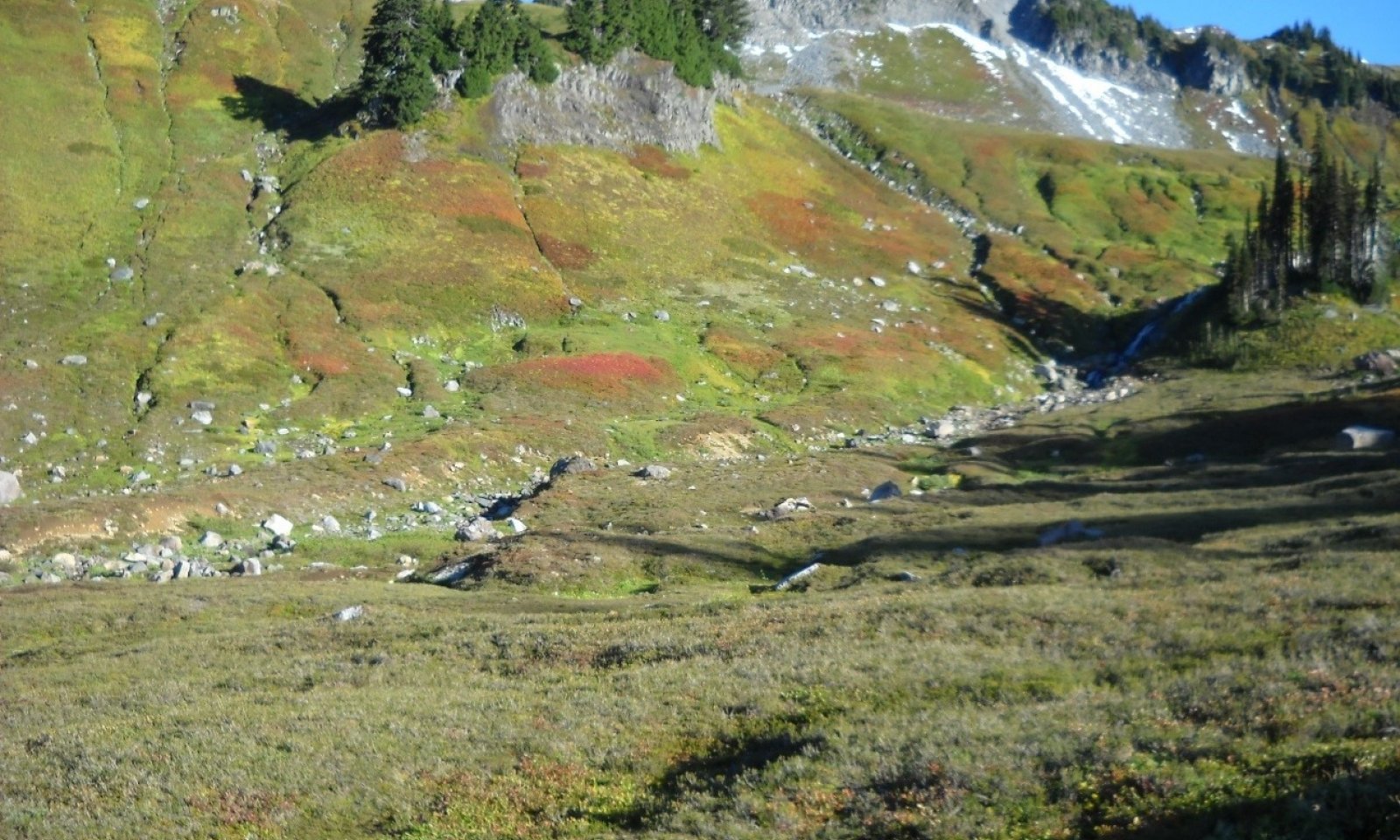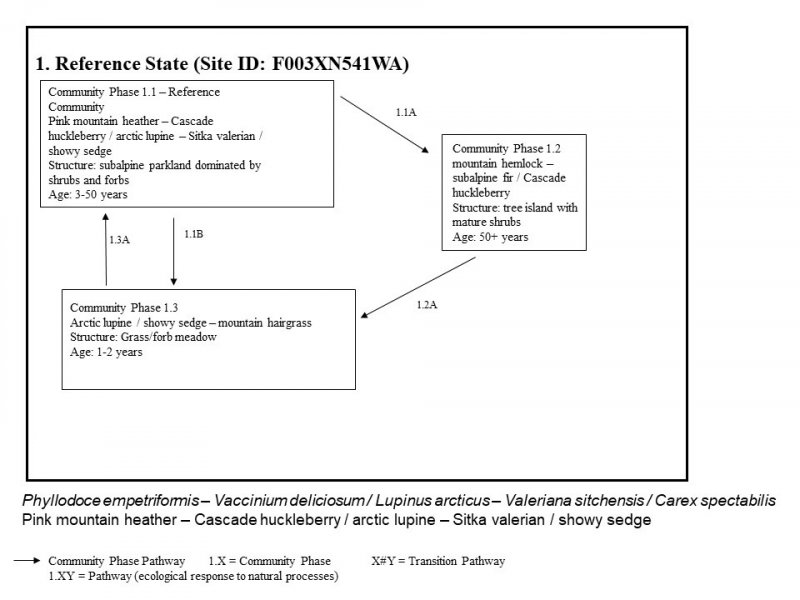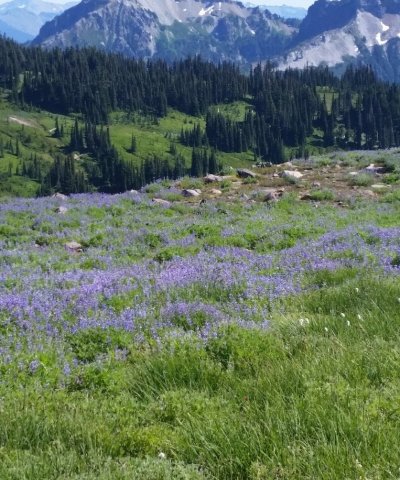

Natural Resources
Conservation Service
Ecological site R003XN541WA
Southern Washington Cascades Moist Subalpine Parkland
Last updated: 1/29/2025
Accessed: 12/05/2025
General information
Provisional. A provisional ecological site description has undergone quality control and quality assurance review. It contains a working state and transition model and enough information to identify the ecological site.
MLRA notes
Major Land Resource Area (MLRA): 003X–Olympic and Cascade Mountains
Steep mountains and narrow to broad, gently sloping valleys characterize this region. A triple junction of two oceanic plates and one continental plate is directly offshore from Puget Sound. Subduction of the oceanic plates under the westerly and northwesterly moving continental plate contributes to volcanic activity in the Cascades. Movement between these plates has resulted in major earthquakes in this area in the past and the formation of large stratovolcanoes. The Cascade Mountains consist primarily of volcanic crystalline rocks with some associated metasedimentary rocks. The average annual precipitation ranges from 60 to 100 inches in much of the region and 30 to 60 inches on the east side of the Cascade Mountains.
The dominant soil orders in this MLRA are Andisols, Spodosols, and Inceptisols, with minor amounts of Entisols, and Histosols. The soils in the area dominantly have a frigid or cryic soil temperature regime and an udic soil moisture regime. They generally are shallow to very deep, well drained, ashy to medial, and loamy or sandy and occur on mountain slopes and ridges.
Ecological site concept
This ecological site is found in subalpine parklands at middle and high elevations of the Southern Washington Cascades. The site is predominantly comprised of low growing shrubs, forbs, and grass species. The site is located on south and west slopes of Mount Rainier, but occurs on all aspects and all slopes within that zone. The site is often influenced by heavy snow loads which provide more soil moisture and insulation for plants during the dormant season. In addition, it receives the highest amount of rainfall within the subalpine parklands located in Mount Rainier National Park, and has a wider degree of vegetative diversity and resilience as a result. Soils that support this ecological site occur in the cryic soil temperature regime and the udic soil moisture regime. Several of the soils have a water table between 10 and 20 inches of the surface at some point of the growing season.
The reference community may be most common, but it is likely that all community phases occur as a matrix across the landscape. Common plants include Cascade huckleberry (Vaccinium deliciosum), pink mountain-heather (Phyllodoce empetriformis), white mountain heather (Cassiope mertensiana), Sitka valerian (Valeriana sitchensis), false hellebore (Veratrum viride), American bistort (Polygonum bistortoides), western columbine (Aquilegia formosa), arctic lupine (Lupinus arcticus), spreading phlox (Phlox diffusa), arrow-leafed ragwort (Senecio triangularis), mountain hairgrass (Vahlodea atropurpurea), and showy sedge (Carex spectabilis).
Associated sites
| R003XN542WA |
Southern Washington Cascades Subalpine Parkland Ecological Site R003XN542WA, Southern Washington Cascades Subalpine Parkland, and Ecological Site R003XN541WA, Southern Washington Cascades Moist Subalpine Parkland are found within the same elevations. Both ecological sites are parkland ecosystems, however moisture availability plays a key role in distinguishing the Ecological Sites. Ecological Site R003XN542WA is more commonly found in rain shadow areas and, as a result, are drier and warmer habitats. Ecological Site R003XN541WA has higher soil moisture and able to support a more diverse vegetative ecosystem with a higher percentage of vegetative cover when compared to site R003XN542WA. |
|---|
Similar sites
| R003XN540WA |
Southern Washington Cascades Wet Subalpine Parkland Ecological Site R003XN540WA, Southern Washington Cascades Wet Subalpine Parkland, has similar features to Ecological Site R003XN541WA, Southern Washington Cascades Moist Subalpine Parkland. Both ecological sites are found in parklands within the same elevation range, however the position on the landscape affects the persistence of snow cover which create a distinct influence on both sites. Ecological Site R003XN540WA is more commonly found in depressions and swales which captures and stores snow for longer periods of the growing season. Wet adapted plants such as black sedge are commonly homogeneous in these growing environments. Ecological Site R003XN541WA has a greater level of plant diversity and production as a result of earlier seasonal snow melt which extends the growing season. |
|---|
Table 1. Dominant plant species
| Tree |
Not specified |
|---|---|
| Shrub |
(1) Phyllodoce empetriformis |
| Herbaceous |
(1) Lupinus arcticus |
Click on box and path labels to scroll to the respective text.


